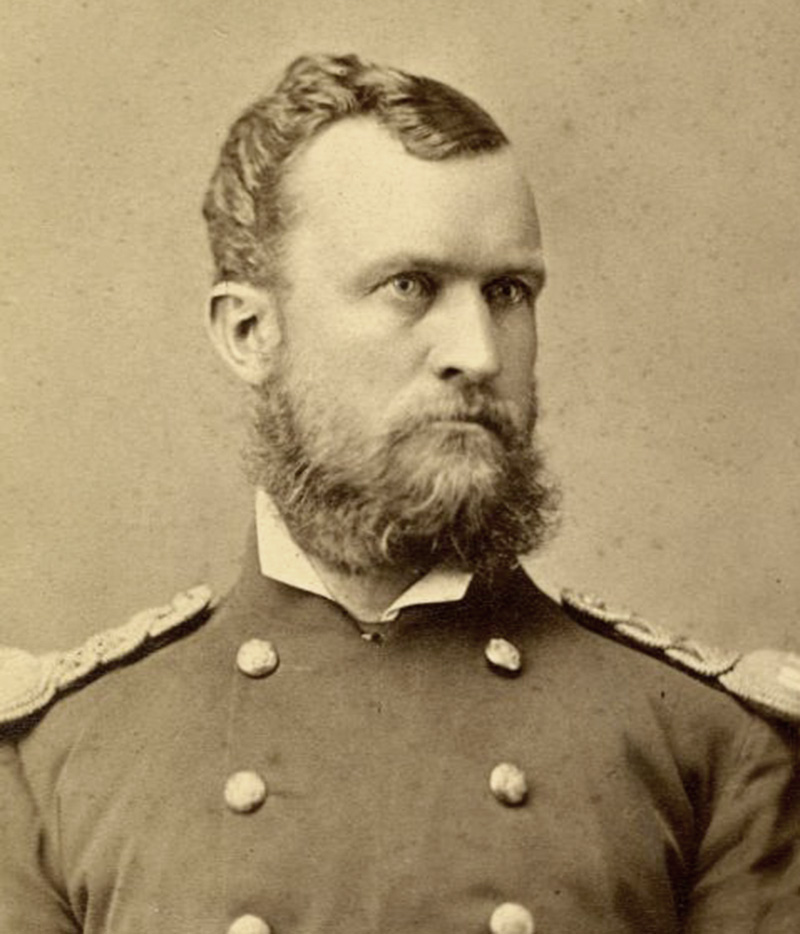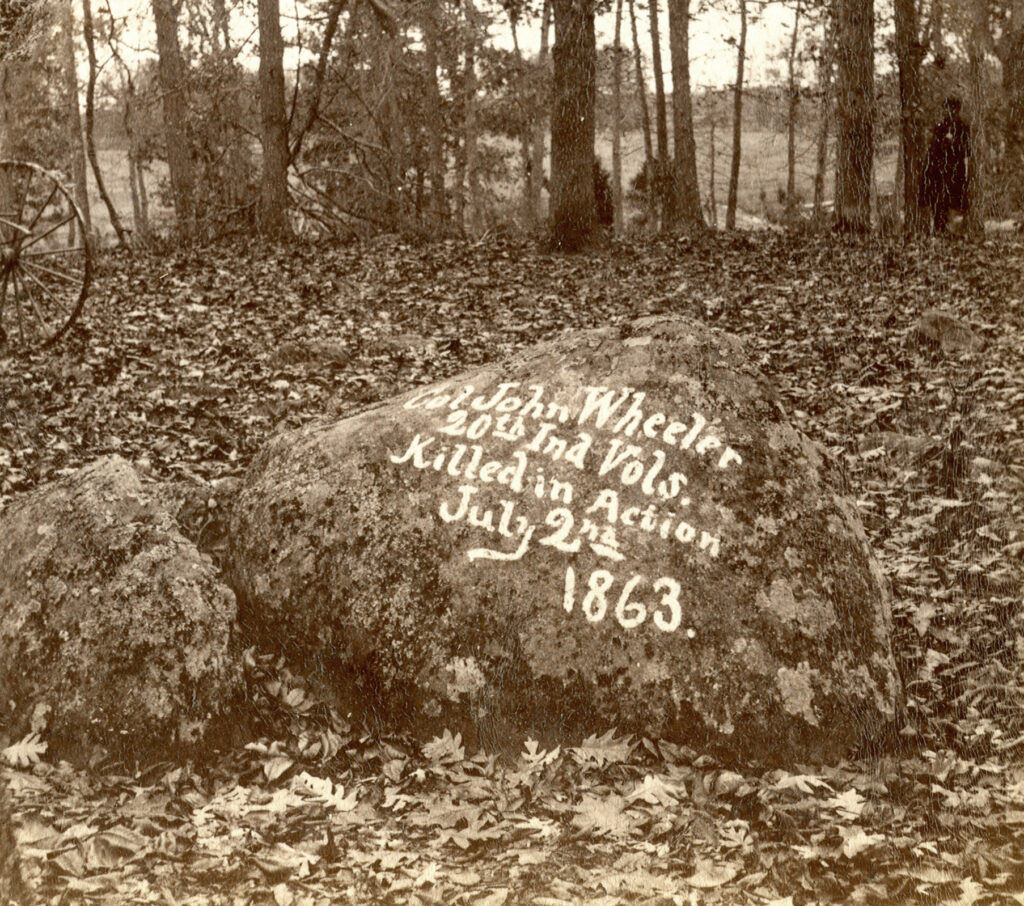When John Wheeler wrote residence within the early hours of July 2, 1863, the thought most likely occurred to him that this may be the final letter he would ever write. The colonel of the twentieth Indiana Infantry was conscious of the looming battle he and his males would face on the second day of Gettysburg, so he could possibly be forgiven for this somber contemplation. Two years earlier, as warfare clouds loomed over the fractured nation, Wheeler had been editor (and co-founder) of his residence state’s newspaper, the Crown Level Register, whose masthead reads, “Unbiased in all issues—Impartial in nothing.” It was a plea he had additionally lived by as a soldier and commander.
In the beginning of the warfare, Wheeler – a distant relative of future Accomplice cavalry common Joseph Wheeler – raised a 100-man firm and was elected captain. Among the many recruits had been the sons of a household good friend: Albert Luther and his brother John, vice chairman of a neighborhood financial institution.
Main the area’s large recruiting effort was Erasmus Corwin Gilbreath, a lawyer and businessman who had helped convey a railroad to the county seat earlier than the warfare. Due to his power and prominence, he was commissioned a lieutenant within the twentieth Indiana.

The twentieth’s first project was to protect railroad strains in Maryland. It was then despatched to the North Carolina coast and stationed at Fort Monroe, Virginia, in January 1862 below Brigadier Common Joseph King Fenno Mansfield, later mortally wounded at Antietam. On March 8, the Hoosiers had been known as to close by Hampton Roads to assist defend the wrecked USS Congress from seize by CSS Virginia . Hearth from the twentieth wounded Virginia U.S. Navy commander Flag Officer Franklin Buchanan, who helped drive off the Accomplice boarding events.
The twentieth, an impressed Mansfield later famous, “might go longer with out meals…eat extra once they obtained it; might undergo extra with out being handicapped; get in line sooner; stand firmer and curse extra loudly than every other physique of males.” On Might 10, 1862, President Lincoln visited Fort Monroe, and whereas watching his fellow Midwesterners put together for an assault on Norfolk, he reportedly cheered, “Bully for the Indiana twentieth!”
The twentieth Regiment joined the Military of the Potomac throughout the Peninsula Marketing campaign and was assigned to Main Common Phil Kearny’s third Division within the third Corps. Kearny raved in regards to the twentieth Regiment’s combating potential at Oak Grove, Savage’s Station, and Glendale throughout the Seven Days Battles, referring to them as “my twentieth Indiana Riflemen.”
“If I had 40,000 males just like the twentieth Indiana,” he declared, “I might battle and whip any military on this planet.”
After combating at Second Bull Run after which at Ox Hill (the place Kearny was killed), the twentieth was assigned to the defenses of Washington, D.C., throughout the subsequent Antietam Marketing campaign, however returned to the Military of the Potomac earlier than the Battle of Fredericksburg. On December 13, 1862—a day Captain Gilbreath described as “virtually September brightness and heat”—the Hoosiers saved Captain George Randolph’s artillery within the third Corps by bringing in ammunition and manning the weapons after the battery misplaced infantry assist. A grateful Randolph famous after the warfare that the twentieth Regiment was “the best regiment, volunteer or common, with which I had the nice fortune to serve… We had been all the time glad to know that [they were] shut.”
Gilbreath suffered a critical wound to his proper leg throughout the combating that day, however bravely refused amputation – and someway survived. The wound, nonetheless, needed to be corrected in 1875. Though he had restricted use of the leg for 2 years and was continually limping, he returned to obligation in April 1863.
Heavy combating in Gettysburg
Within the spring of 1863, Wheeler was promoted to colonel and given command. John Luther was appointed lieutenant and have become Wheeler’s aide-de-camp. Through the Chancellorsville Marketing campaign, the twentieth Regiment helped lead the advance of the third Corps and captured a horde of prisoners from the twenty third Georgia Infantry in Brigade. Gen. Alfred Colquitt’s Brigade, a part of Lt. Gen. Stonewall Jackson’s Second Corps.
Later, the Hoosiers had been concerned in an evening motion, serving within the rear guard throughout the retreat throughout the Rappahannock River. Brigadier Common John Henry Hobart Ward, their brigade commander, praised the regiment’s “coolness and undaunted braveness” and famous that it was in a position to “keep the well-deserved popularity it earned on the Peninsula.” Wheeler was happy with his males’s efficiency in “one of many hardest [battles]” and confidently wrote residence that “Western males are the true deal. [The army] might do much more if we had…extra males from Maine and the West…we’re all doing effectively and are ready for no matter could come our method.”
What got here would show to be a extreme take a look at. The twentieth arrived at Gettysburg after darkish on July 1 and spent a tense night time sleeping with their weapons on the prepared on the Union left on the south finish of Cemetery Ridge. On July 2, the regiment was stationed with most of Ward’s 2nd Brigade within the Rose Woods on Houck’s Ridge. With the launch of Lieutenant Common James Longstreet’s assault at 4 p.m., the Hoosiers (together with the 86th New York) quickly discovered themselves in fierce skirmishes with the third Arkansas. The Union troops initially succeeded, pushing the Southerners again and advancing as Ward had ordered, solely to be ordered again a short while later.
As he had ominously feared, Wheeler was an early casualty, shot from his horse and falling useless in opposition to the distinguished boulder throughout the road from the present twentieth Century Monument. He was shortly buried by the Luther Brothers.
The taking pictures was quick and heavy, and when John rejoined the fray with a discarded rifle, he was hit by a spent bullet and was dazed. Describing the motion to his household, Albert wrote, “[We] needed to fireplace extra slowly as a result of [the] gun barrels had turn out to be so scorching…[we] might hardly maintain them.”
Ward’s males resisted the Southern assault for greater than an hour, however by 5:30 p.m., after Lafayette McLaws’ Georgians joined the battle, the Confederates gained the higher hand. Gilbreath assumed command of the twentieth when Lieutenant Colonel William CL Taylor was wounded. Conscious that his males had been low on ammunition, Ward ordered the twentieth and its close by regiments to withdraw.
Gilbreath was irritated on the method the rebels laughed when the Hoosiers’ flag fell, and was glad that these colours had been instantly recovered and the battle had been something however a defeat. The twentieth, in keeping with the official information , “maintained the place assigned to it till the brigade started to retreat…[and] fell again in good order.”
In accordance with one report, the twentieth Brigade “moved 300 yards to the rear, the place it halted and re-formed its ranks.” Official experiences and recollections from neighboring regiments, in addition to captured/lacking numbers for Ward’s whole brigade, affirm that Ward was in a position to convey his males again from Houck’s Ridge in good order, opposite to the favored perception that the third Corps merely folded and ran away when attacked.

On July 3, the twentieth was despatched to the middle of the road for “cleanup” after Pickett’s Cost and later assigned to burial obligation.
Gettysburg had been a memorable battle for the Hoosiers. Dudley Chase, an Indiana decide who was wounded at Rose Woods whereas serving with the seventeenth U.S. Regulars, later recalled that they “fought desperately… from the jaws of demise and on the gates of hell…” The fee was excessive. Of the 401 males engaged, the twentieth had 32 killed, 114 wounded, and 10 captured/lacking. These totals accounted for 25 p.c of Ward’s deaths throughout the battle and 20 p.c of his complete losses.
Regardless of the bloodshed, some males had been in excessive spirits. One Hoosier wrote residence reporting 14 casualties in his firm alone, however threatened the rebels with a “howl [ sic ]” and a “sound beating” if the Southerners didn’t shortly return to Virginia.
Albert Luther boasted to his household that Lee’s males had “obtained a superb whipping” and that “[w]e are prepared and keen to offer them one other battle.” The next arduous pursuit of the Military of Northern Virginia to the Potomac River left a number of the Hoosiers shoeless, and the tempo diminished Albert’s zeal; in reality, he felt “so drained at night time I might hardly stand.” The anticipated showdown with Lee’s defeated military wouldn’t happen, because the Confederates had been again in Virginia by July 14.
The Final One Left
In August 1863, the twentieth, one of many Western regiments, was given the grueling job of sustaining order in New York Metropolis following the Draft Riots of July. Though Gilbreath selected to romanticize the well-known metropolis (“Most of us had solely dreamed of [this]”), his regiment didn’t relent even for a second, and as soon as encountered “a howling mob” who “mounted bayonets, marched away, driving the gang earlier than us.”
Because the overland marketing campaign approached within the spring of 1864, John Luther expressed concern and optimism—”all dread the onerous marketing campaign that stares us within the face”—but in addition appreciated that the Military of the Potomac had by no means been so formidable. Nonetheless, the combating in Might and June left him despondent: “After the toughest battle that ever was, I’m nonetheless alive, and that’s all…” Expressing each resignation and reduction, he wrote from Chilly Harbor, Virginia: “It appears a miracle that I’m right here, that it’s my luck to have been spared to this point…”
Within the later reorganization of the Military of the Potomac, the boys of the seventh, 14th, and nineteenth Indiana had been mixed into the twentieth Military, which was renamed the “twentieth Indiana Veteran Volunteer Infantry.” This was one other supply of pleasure for the boys of the twentieth century. “No better praise might be paid to you,” mentioned Chase at their reunion in 1888.
The opposite Indiana regiments, all with memorable service, turned members of the twentieth Regiment. The twentieth was the “final remaining” Indiana Infantry Regiment within the Military of the Potomac. It was lively throughout the Petersburg and Appomattox campaigns, firing its final weapons on April 9, 1865. Again in Indianapolis, the twentieth mustered out in July.
John Wheeler was buried in Crown Level on July 30, 1863, within the presence of almost a thousand mourners, together with the 2 Luther brothers. To at the present time, town has not forgotten the colonel and in 2007 named a brand new college in his honor, the place his uniform and murals commemorating the twentieth are on show.
The Luther brothers survived the warfare. John lived till 1924 and was lucky sufficient to attend the fiftieth anniversary reunion at Gettysburg in 1913. Albert was not so blessed and died earlier than his thirtieth birthday. The 2 are buried simply yards from Wheeler in Maplewood Cemetery.
Gilbreath made a profession within the navy and died on lively obligation in 1898. He’s buried together with his spouse and daughter in Arlington Nationwide Cemetery. A household heirloom was a handkerchief stained with Lincoln’s blood (his father-in-law was a good friend of the assassinated president).
In 1889, on the ceremony dedicating the development of the Troopers and Sailors Monument in Indianapolis, the twentieth was the one Indiana unit whose flag was positioned within the cornerstone—its troopers had been additionally “the final males standing” at residence.
Charles J. Rebesco, a lead creator, writes from Munster, Indiana.
This text initially appeared within the Spring 2024 problem of America’s Civil Conflict journal.
